lights OLDSMOBILE SILHOUETTE 1995 Owners Manual
[x] Cancel search | Manufacturer: OLDSMOBILE, Model Year: 1995, Model line: SILHOUETTE, Model: OLDSMOBILE SILHOUETTE 1995Pages: 390, PDF Size: 20.27 MB
Page 9 of 390
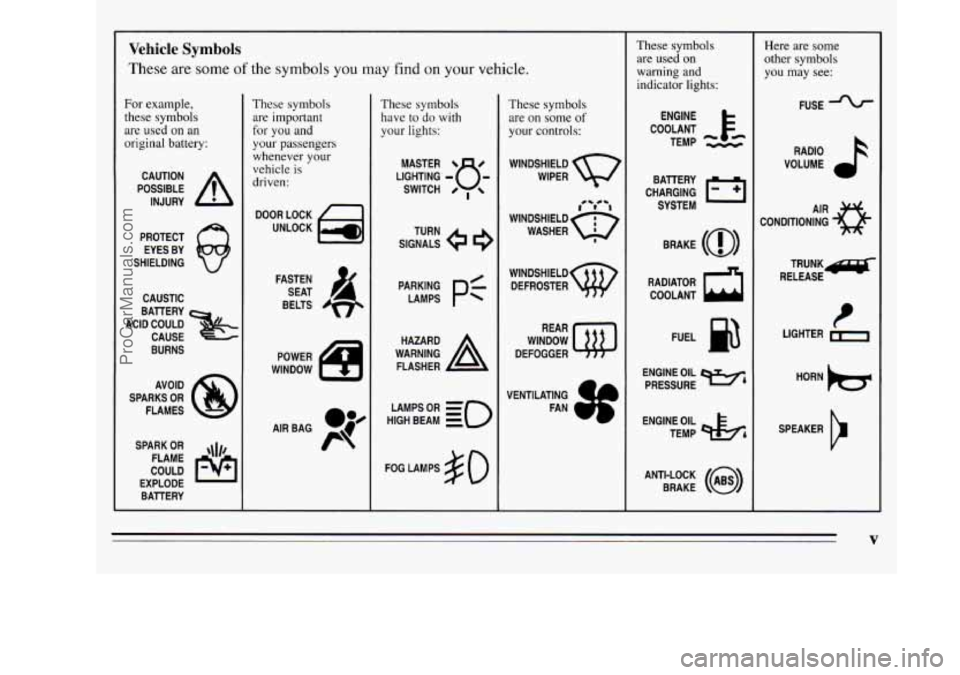
L
Vehicle Symbols
These are some of the symbols you may find on your vehicle.
For example,
these symbols are used on an
original battery:
POSSIBLE A
CAUTION
INJURY
PROTECT EYES BY
SHIELDING
CAUSTIC
ACID COULD BAlTERY
CAUSE
BURNS
AVOID
SPARKS
OR
FLAMES
SPARK
OR ,111,
COULD FLAME
EXPLODE BAllERY
These symbols are important
for you and
your passengers whenever your
vehicle is
driven:
DOOR LOCK
UNLOCK
FASTEN SEAT
BELTS
POWER
WINDOW
These symbols have to do with
your lights:
SIGNALS e e3
TURN
WARNING
A
HAZARD
FLASHER
HIGH
LAMPSoR BEAM = zo
FOG LAMPS $0
These symbols
are on some
of
your controls:
WINDSHIELD
WIPER
WINDSHIELD DEFROSTER
WINDOW
DEFOGGER
VENTILATING FAN
These symbols are used on
warning and
indicator lights:
COOLANT F-
TEMP --
ENGINE
CHARGING BAllERY
SYSTEM
BRAKE
(a)
RADIATOR COOLANT
a
FUEL
ENGINE OIL
PRESSURE
w4
TEMP OIL pk;
ANTI-LOCK (a)
BRAKE
Here are some
other symbols
you may see:
FUSE
RADIO
VOLUME
CONDITIONING
43
TRUNX~
RELEASE
HORN
)tr
SPEAKER
b
V
ProCarManuals.com
Page 93 of 390
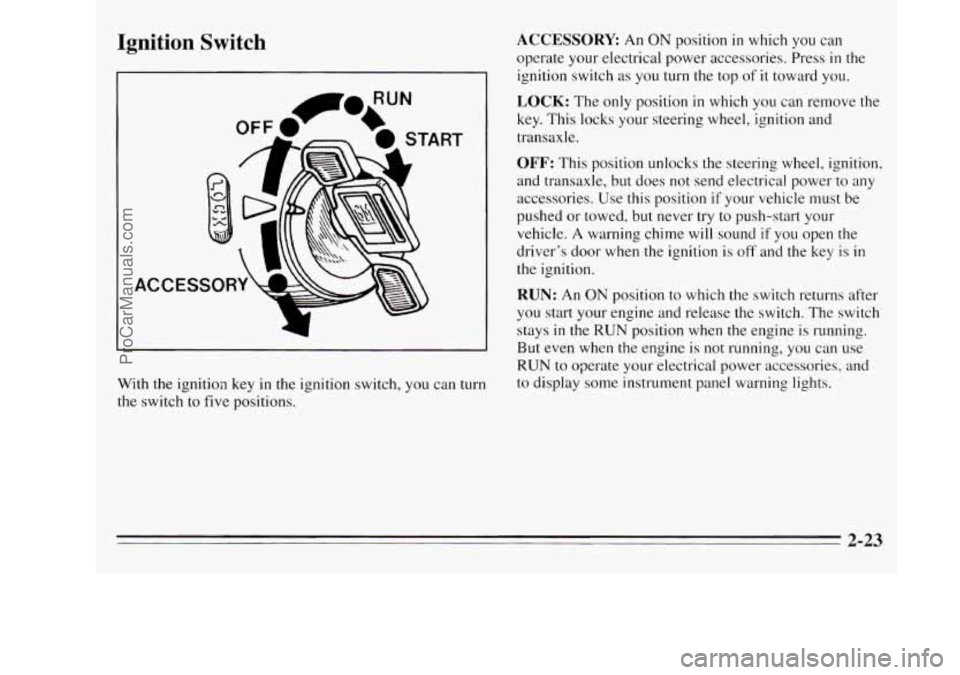
Ignition Switch
ACCE
With the ignition key in the ignition switch, you can turn
the switch to five positions.
ACCESSORY An ON position in which you can
operate your electrical power accessories. Press
in the
ignition switch
as you turn the top of it toward you.
LOCK: The only position in which you can remove the
key. This locks your steering wheel, ignition and
transaxle.
OFF: This position unlocks the steering wheel, ignition,
and transaxle, but does not send electrical power to any
accessories. Use this position
if your vehicle must be
pushed or towed, but never try
to push-start your
vehicle. A warning chime will sound if
you open the
driver’s door when the ignition is off and the key is in
the ignition.
RUN: An ON position to which the switch returns after
you start your engine and release the switch. The switch
stays in
the RUN position when the engine is running.
But even when the engine is not running, you can use
RUN to operate your electrical power accessories, and
to display some instrument panel warning lights.
2-23
ProCarManuals.com
Page 119 of 390

Headlamps
PE: Push this switch to turn on:
0 Parking Lamps
0 Sidemarker Lamps
0 Taillamps
Instrument Panel Lamps
Pull the switch to turn
off the lamps.
-‘a- ‘ I : Push this switch to turn on the headlamps, together
with:
0 Parking Lamps
0 Sidemarker Lamps
0 Taillamps
0 Instrument Panel Lamps
Pull the switch
to turn off the lamps.
Instrument Panel Intensity Control
Slide the upper lights control all the way up to increase
the brightness
of the instrument panel lamps, down to
decrease the brightness. Slide the control all the way
down to turn them
off.
Lamps On Reminder
If you turn the ignition key to the OFF or LOCK
position while leaving the lamps on, you will hear a
warning chime.
ProCarManuals.com
Page 120 of 390

Headlamp High-Low Beam Changer
To change the headlamps from high to low beam, or low
to high, simply pull the turn signal lever all the way
toward you. Then release it.
When the high beams are on, a blue light on the
instrument cluster will
also be on.
Fog Lamps
Slide the lower lever on the lights control panel up to
turn
on the fog lamps, down to turn them off. An
indicator light next to the control will glow when the fog
lamps are on.
Your headlamps must be on for your fog lamps to go on.
Although your fog lamps will go off when your high
beams are on, high beams are not recommended for
driving in fog.
~
2-50
ProCarManuals.com
Page 125 of 390
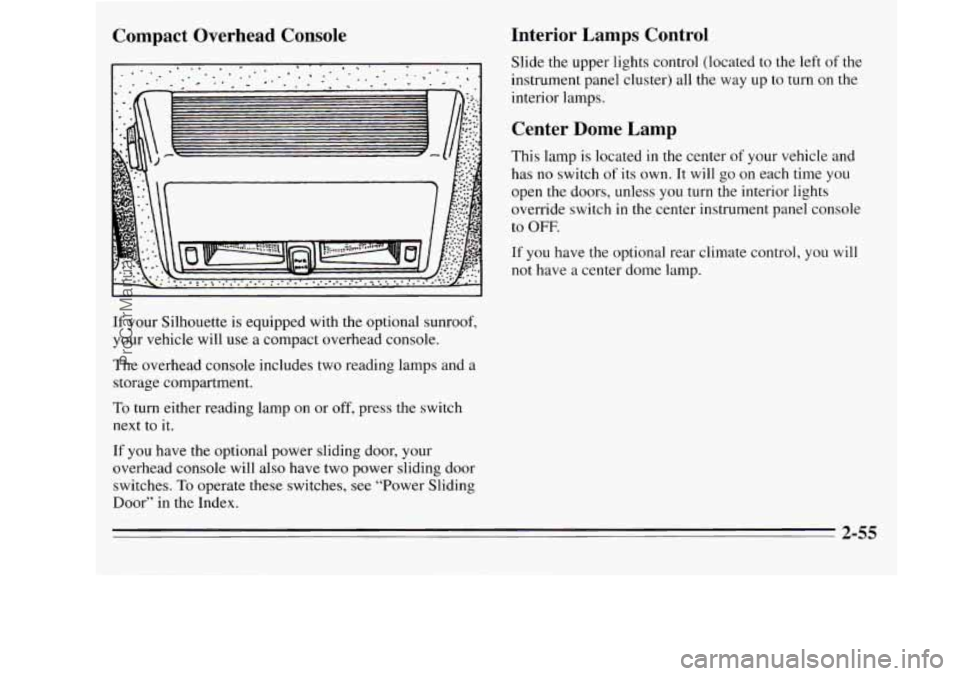
Compact Overhead Console
If your Silhouette is equipped with the optional sunroof,
your vehicle will
use a compact overhead console.
The overhead console includes two reading lamps and a
storage compartment.
To turn either reading lamp on or off, press the switch
next to
it.
If you have the optional power sliding door, your
overhead console will also have two power sliding door
switches.
To operate these switches, see “Power Sliding
Door” in the Index.
Interior Lamps Control
Slide the upper lights control (located to the left of the
instrument panel cluster) all the way up to turn on the
interior lamps.
Center Dome Lamp
This lamp is located in the center of your vehicle and
has no switch
of its own. It will go on each time you
open the doors, unless you turn the interior lights
override switch
in the center instrument panel console
to OFF.
If you have the optional rear climate control, you will
not have a center dome lamp.
2-55
ProCarManuals.com
Page 126 of 390

Rear Interior Lamps
The rear dome lamp also has two reading lamps.
The dome lamp will go on each time you open the
doors, unless you
turn the interior lights override switch
in the center instrument panel console to OFF.
To turn on either reading lamp, press the switch next to it.
There are also two lamps in the liftgate to light the rear
cargo area. These will come on each time you open the liftgate, unless the interior
lights override switch is in
the
OFF position.
Interior Lights Override Switch
This switch is located to the left of the cigarette lighter
in the center instrument panel console. It has two
positions,
DOOR (on) and OFF, and overrides all
interior lamps except the reading lamps.
The interior lamps go
on each time you open the doors.
You can
turn off these lamps so that the doors may be
left open without running down the battery by turning
the interior lights override switch to
OFF.
2-56
ProCarManuals.com
Page 128 of 390
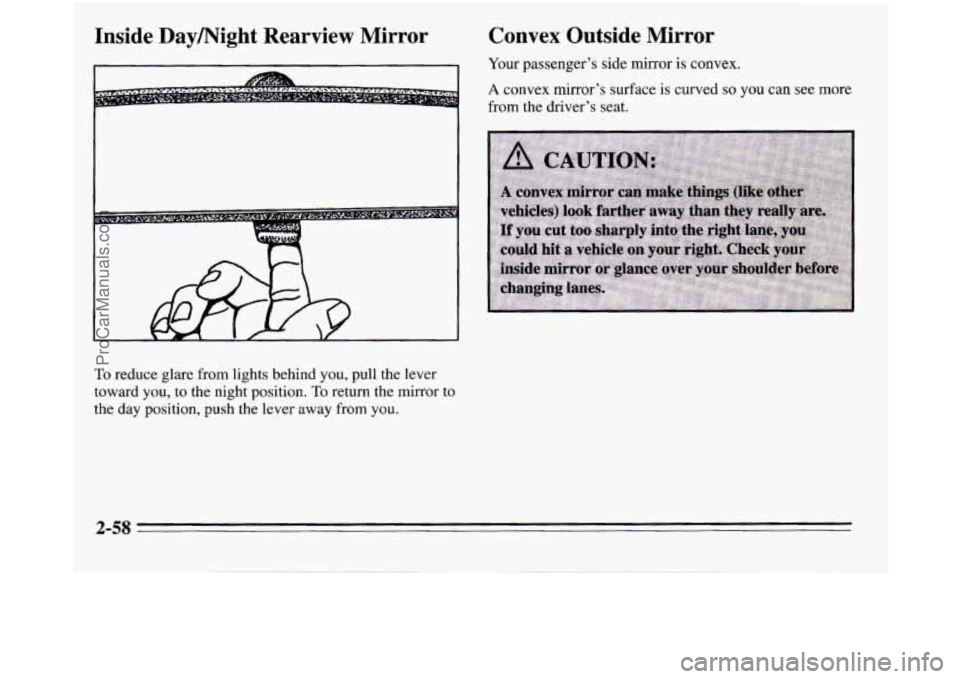
Inside Daymight Rearview Mirror Convex Outside Mirror
Your passenger’s side mirror is convex.
A convex mirror’s surface is curved so you can see more
from the driver’s seat.
To reduce glare from lights behind you, pull the lever
toward you, to the night position.
To return the mirror to
the day position, push the lever away from
you.
2-58
ProCarManuals.com
Page 141 of 390
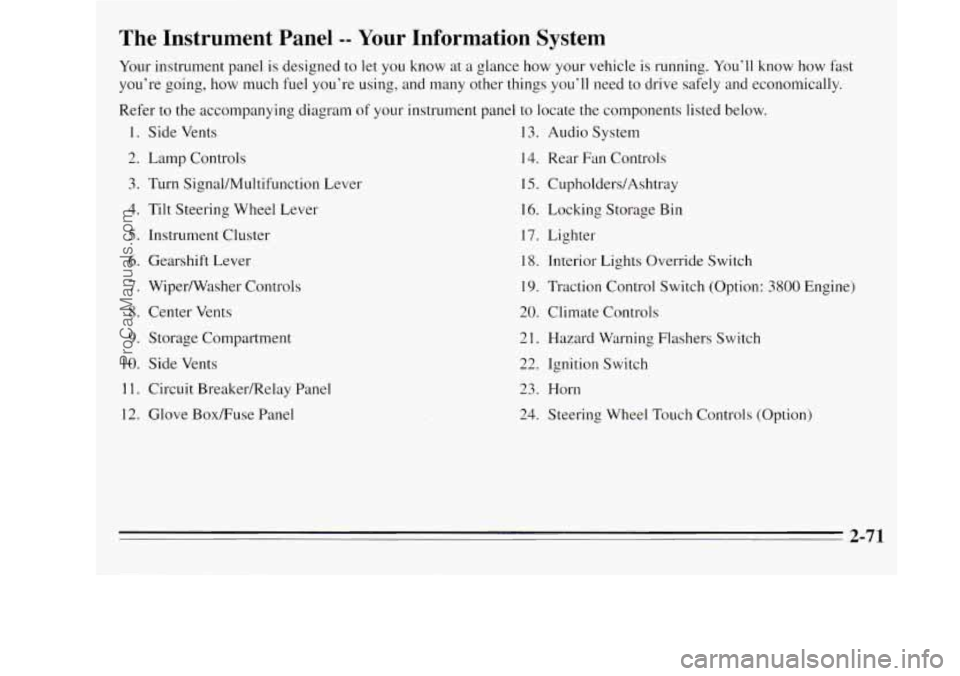
The Instrument Panel -- Your Information System
Your instrument panel is designed to let you know at a glance how your vehicle is running. You’ll know how fast
you’re going, how much fuel you’re using, and many other things you’ll need to drive safely and economically.
Refer to the accompanying diagram
of your instrument panel to locate the components listed below.
1. Side Vents 13. Audio System
2. Lamp Controls
14. Rear Fan Controls
3. Turn Signal/Multifunction Lever 15. CupholderdAshtray
4. Tilt Steering Wheel Lever 16. Locking
Storage Bin
5. Instrument Cluster 17. Lighter
6. Gearshift Lever
18. Interior Lights Override Switch
7. Wiper/Washer Controls 19. Traction Control Switch (Option: 3800 Engine)
8. Center Vents
20. Climate Controls
9. Storage Compartment 21. Hazard Warning Flashers Switch
10. Side Vents
22. Ignition Switch
1 1. Circuit BreakedRelay Panel 23. Horn
12. Glove BoxRuse Panel
24. Steering Wheel Touch Controls (Option)
-
2-71
ProCarManuals.com
Page 142 of 390

Instrument Panel Cluster (3800 V6 Shown, 3.1L V6 Similar)
Your cluster includes indicator warning lights and gages that are explained on the following pages.
2-72
ProCarManuals.com
Page 145 of 390
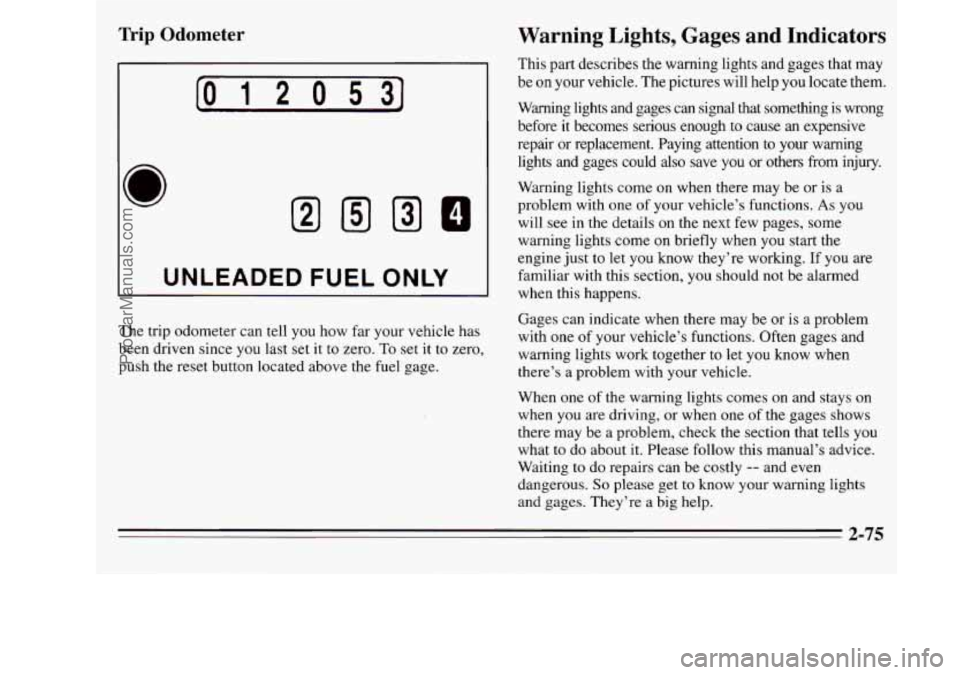
Trip Odometer
[O 12 O 531
I UNLEADED FUEL ONLY I
The trip odometer can tell you how far your vehicle has
been driven since you last set it to zero.
To set it to zero,
push the reset button located above the fuel gage.
Warning Lights, Gages and Indicators
This part describes the warning lights and gages that may
be on your vehicle. The pictures will help
you locate them.
Warning lights and gages
can signal that something is wrong
before it becomes serious enough to cause
an expensive
repair or replacement. Paying attention
to your warning
lights and gages could also save you or others
from injury.
Warning lights come on when there may be or is a
problem with one
of your vehicle’s functions. As you
will see in the details on the next few pages, some
warning lights come
on briefly when you start the
engine just to let you know they’re working.
If you are
familiar with this section,
you should not be alarmed
when this happens.
Gages can indicate when there may be or is a problem
with
one of your vehicle’s functions. Often gages and
warning lights work together to let
you know when
there’s a problem with your vehicle.
When one of the warning lights comes on and stays on
when
you are driving, or when one of the gages shows
there may be a problem, check the section that tells you
what to do about it. Please follow this manual’s advice.
Waiting
to do repairs can be costly -- and even
dangerous.
So please get to know your warning lights
and gages. They’re
a big help.
2-75
ProCarManuals.com